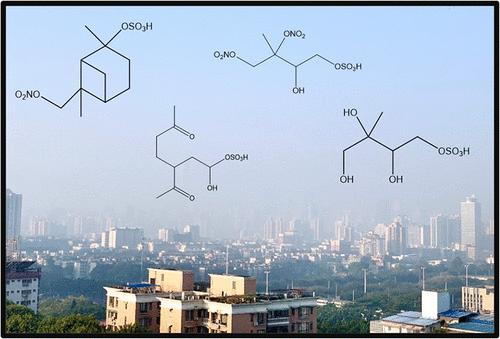当前位置:
X-MOL 学术
›
ACS Earth Space Chem.
›
论文详情
Our official English website, www.x-mol.net, welcomes your
feedback! (Note: you will need to create a separate account there.)
Importance of Oxidants and Temperature in the Formation of Biogenic Organosulfates and Nitrooxy Organosulfates
ACS Earth and Space Chemistry ( IF 2.9 ) Pub Date : 2021-09-05 , DOI: 10.1021/acsearthspacechem.1c00204 Daniel J. Bryant 1 , Atallah Elzein 2 , Mike Newland 3 , Erin White 1 , Stefan Swift 1 , Amy Watkins 1 , Wei Deng 4 , Wei Song 4 , Sainan Wang 5 , Yanli Zhang 4 , Xinming Wang 4 , Andrew R. Rickard 1, 6 , Jacqueline F. Hamilton 1
ACS Earth and Space Chemistry ( IF 2.9 ) Pub Date : 2021-09-05 , DOI: 10.1021/acsearthspacechem.1c00204 Daniel J. Bryant 1 , Atallah Elzein 2 , Mike Newland 3 , Erin White 1 , Stefan Swift 1 , Amy Watkins 1 , Wei Deng 4 , Wei Song 4 , Sainan Wang 5 , Yanli Zhang 4 , Xinming Wang 4 , Andrew R. Rickard 1, 6 , Jacqueline F. Hamilton 1
Affiliation

|
Biogenic secondary organic aerosol (BSOA) makes up a significant proportion of organic aerosol, and its formation chemistry, composition, and physical properties can be influenced by anthropogenic emissions, especially in urban areas. Organosulfates (OSs) are an important class of tracers for BSOA and have been well-studied over the past decade, although detailed ambient studies of diurnal variations are still lacking. In this study, fine particulate matter samples were collected eight times a day across summer and winter campaigns at an urban site in Guangzhou, China. Guangzhou is heavily influenced by both biogenic and anthropogenic emissions, allowing for biogenic–anthropogenic interactions to be studied. Individual OSs and nitrooxy OSs (NOSs) species derived from monoterpenes and isoprene were analyzed using ultrahigh-performance liquid chromatography tandem mass spectrometry (UHPLC–MS2) and quantified using three authentic and proxy standards. The observations show strong diurnal variations of monoterpene derived OSs and NOSs, which peaked during the night, with concentrations increasing from the early evening, highlighting the role of NO3-oxidation chemistry. Isoprene derived OSs/NOSs showed strong seasonal profiles, with summer and winter average concentrations of 181.8 and 69.5 ng m–3, respectively, with exponential increases observed at temperatures above 30 °C. Low-NO formation pathways were dominant in the summer, while high-NO pathways became more important in the winter. Isoprene OS formation was strongly dependent on the availability of particulate sulfate (SO42–), suggesting an extensive heterogeneous chemistry of oxidized isoprene species. Overall, this study provides further insights into biogenically derived OS and NOS formation within highly anthropogenically influenced environments.
更新日期:2021-09-16











































 京公网安备 11010802027423号
京公网安备 11010802027423号